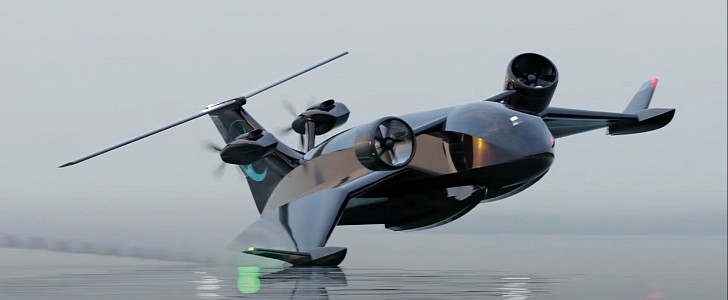The Flying Ship Company is currently working toward introducing a new type of maritime cargo transport vehicle and they claim it will disrupt the global logistics market, creating new opportunities.
The vehicle in question, while not completely revolutionary, is quite unique and interesting, as their website states that it will provide a fast, yet cost-effective alternative to traditional cargo operations, being up to 10 times faster than a ship. Another thing to keep in mind is that this kind of vessel might be able to provide vital emergency relief supplies in response to natural disasters.
They aim to achieve this by taking inspiration from a late 60s design and bringing it up to date with modern era technology, materials and electric engines, making it an environmentally friendly vehicle that flies just over the water. The design in question comes courtesy of Soviet Russia and their Ekranoplan project.
This kind of vessel takes advantage of something called ground effect, which will reduce drag and use the downwash from the wings to create a cushion of air below them. This cushion of air is important because it increases lift. This added lift allows for 30-50% less energy to be used compared to traditional aircraft when transporting the same weight. It is also intended for this vessel to be equipped with cutting edge autonomous technology in order to make it unmanned.
Going into the specifics, the initial models will be semi-autonomous, with a length of 30 feet, featuring fully electric engines, a range of 500 nautical miles and a cargo capacity of 1200 kilograms. Future generations will not only be fully autonomous, but they will also be larger and will make use of alternative green propulsion technologies in order to increase the range up to 1000 nautical miles and the cargo capacity up to 2700 kilograms. Their classification as marine vessels means the Flying Ships won’t be governed by airspace regulators, allowing for quicker entry to market and lower operating costs.
The science behind this project is most certainly real and it has been used before in vehicles of exponentially larger size than what The Flying Ship Company is aiming for, however those projects were abandoned without seeing significant success. Some questions remain as to whether they will be able to solve the issues that accompany such a project and if the autonomous technology can cope with the tremendously difficult task of operating the vessel within ground effect, but considering a test flight has already been performed, we’re curious to see how things will play out.
They aim to achieve this by taking inspiration from a late 60s design and bringing it up to date with modern era technology, materials and electric engines, making it an environmentally friendly vehicle that flies just over the water. The design in question comes courtesy of Soviet Russia and their Ekranoplan project.
This kind of vessel takes advantage of something called ground effect, which will reduce drag and use the downwash from the wings to create a cushion of air below them. This cushion of air is important because it increases lift. This added lift allows for 30-50% less energy to be used compared to traditional aircraft when transporting the same weight. It is also intended for this vessel to be equipped with cutting edge autonomous technology in order to make it unmanned.
Going into the specifics, the initial models will be semi-autonomous, with a length of 30 feet, featuring fully electric engines, a range of 500 nautical miles and a cargo capacity of 1200 kilograms. Future generations will not only be fully autonomous, but they will also be larger and will make use of alternative green propulsion technologies in order to increase the range up to 1000 nautical miles and the cargo capacity up to 2700 kilograms. Their classification as marine vessels means the Flying Ships won’t be governed by airspace regulators, allowing for quicker entry to market and lower operating costs.
The science behind this project is most certainly real and it has been used before in vehicles of exponentially larger size than what The Flying Ship Company is aiming for, however those projects were abandoned without seeing significant success. Some questions remain as to whether they will be able to solve the issues that accompany such a project and if the autonomous technology can cope with the tremendously difficult task of operating the vessel within ground effect, but considering a test flight has already been performed, we’re curious to see how things will play out.











